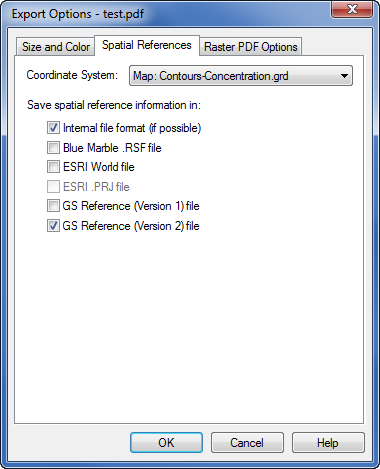
Some applications associate spatial reference information (such as projection, datum, and georeference parameters) with files, to link the file to a specific region of the Earth’s surface. If the map that you are exporting has a coordinate system defined, the Spatial References tab will appear in the Export Options dialog.

The Spatial References page allows you to choose how to save
the projection, datum, and georeference information.
Next to Coordinate System, select the appropriate coordinate system to use when exporting the file. Available options are Paper space (page units), all map frame names in the MapViewer file, and any coordinate system for each image in the MapViewer file. To select the appropriate map, click on the existing map name and select the desired map from the list. All objects are exported in the selected Coordinate System.
If a single Map is selected in the plot window, the map coordinate system is used for the Coordinate System. If a single image is selected in the plot window, the coordinate system for the image is used for the Coordinate System. If more than one Map object is selected, the Coordinate System is set to Paper space (page units). This can be changed to any of the Map coordinate systems in the list and all objects will be exported to this coordinate system.
To export only some of the objects to the desired coordinate system, select the objects first and check the Export selected objects only option on the Export dialog.
The Coordinate System option is not available for all file formats. With most vector formats (DXF, SHP, etc.), the Coordinate System option is on the Scaling tab.
Most bitmap file storage formats don’t have a way to store the spatial reference information in the same file as the bitmap image. For these formats, the only way the spatial reference information can be saved is in a separate file. If the selected Coordinate System supports georeferencing information, the appropriate reference file options will be enabled. If the selected Coordinate System has a warp, only the reference file formats that support warp will be enabled.
Internal File Format (if Possible)
If the export format can internally store the georeference information, check this box. The spatial reference information will be stored (along with the image) in the selected format. One format that stores the coordinate reference is a TIF file, a vendor-independent format that can be imported into a variety of geographic software packages.
Blue Marble .RSF File
Blue Marble Geographics supports a text-based format for storing georeference information in a separate file. Various Blue Marble programs will import the information in this file when importing the bitmap file.
ESRI World file
Environmental Sciences Research Institute (ESRI) supports a text-based format for storing georeference information in a separate file. Various ESRI programs will import the information in this file when importing the bitmap file. The first and third characters of the image file’s suffix, plus a final "w", are used for the world file suffix. Therefore, "mytown.tif" will have a world file called "mytown.tfw"; for "redlands.bmp", it will be "redlands.bpw".
ESRI .PRJ File
Environmental Sciences Research Institute (ESRI) supports a text-based format for storing georeference information in a separate file. Various ESRI programs will import the information in this file when importing vector files, such as .SHP files.
GS Reference (Version 1) File
Golden Software supports a text-based format for storing spatial reference information in a separate file. Projection, datum and georeference information can be stored in this format. The file will be created having the same name as the exported bitmap, with the suffix ".GSR" appended. The .GSR file is an older format Golden Software reference file.
GS Reference (Version 2) File
Golden Software's .GSR2 file is a newer georeference file format that includes spatial reference information in a separate file. Projection, datum and georeference information can be stored in this format. The file will be created having the same name as the exported file, with the suffix ".GSR2" appended.
See Also